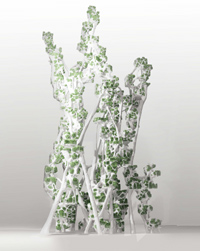The Museum Tinguely in Basel and Kunsthaus Graz are co-organising an exhibition that addresses the subjects of “Artificial Intelligence” and “Robotics”. The title Robot Dreams is borrowed from a short story of the same name by Isaac Asimov, a biochemist and extraordinarily prolific writer of science fiction, in which Elvex, a robot, has to be destroyed because he has a dream in which he plans a revolt and starts to disregard the Three Laws that are intended to keep him subservient to humans.
Robots in everyday life
The exhibition looks at recent advances in Artificial Intelligence research and, through the medium of artistic projects, seeks to explore the broad topic of Robots and its association with various concepts. The questions here focus in particular on the interaction between man and machine, Embodiment, the feedback from these developments and its influence on human perception and behaviour, and the use of robots in everyday life. What is regarded today as utopian, even a source of disquiet, may tomorrow be part and parcel of household appliances. Communicating with the refrigerator, autonomous robotic vacuum cleaners and adaptive seat memory electronics in cars are already contemporary reality, as are nano-robots for medical use or software that is able to learn from its mistakes and adapt appropriately.
Contemporary art and science
The artists had virtually complete freedom to produce the works shown in the approximately 1000 m2 exhibition space devoted to Robot Dreams. They provide answers from very different perspectives to the question as to what contemporary art can contribute to our understanding and handling of the latest developments in the natural sciences.
The visitor becomes an active participant in multimedia environments that illustrate the possibilities and limits of this interaction. John Bock's history-inspired film oeuvre and Virgil Widrich's anthology of film cover a century of the development and aesthetic of films and literature on robots and robotics. Kirsty Boyle's work is influenced by Japanese Karakuri figures and combines contemporary research with the great tradition of Japanese automata. Using the technique of speech recognition, Sibylle Hauert and Daniel Reichmuth create an interactive experimental setting that leaves us uncertain as to whether we are (still) humans or machines, while Jon Kessler's huge, circular installation inspired by Alexander Calder and Sisyphus elucidates the absurd logic behind acts of war.
 R&Sie(n) with Stephan Henrich Une architecture des humeurs, 2010
Installation François Roche Collection, Commission and Production «Le Laboratoire de Paris»
© 2010 R&Sie(n) mit Stephan Henrich, Courtesy «Le Laboratoire de Paris»
Photo: Matthieu Kavyrchine
Niki Passath’s work focuses on swarm robots as a decentralised organisational form of artificial intelligence and on their ability to react to people. The architect François Roche, on the other hand, shows how building with the help of improvisational robotics and totally new materials could help us to return to bionic forms. Thomas Baumann researches ex negativo the possibilities of Anti-robots and uncovers a number of aspects that motivate our interest in robots. Finally, the topic of Luc Mattenberger's jet-ski for suicide bombers is man as a (ideologically) remote-controlled robot. In addition to these recent projects, the show includes art works that complement the broad topics of Robotics and Artificial Intelligence, among them pieces that have been specifically mentioned by the participating artists as inspiration for works of their own. These include works by Yan Duyvendak, Jessica Field, Ed Kienholz, Richard Kriesche, Nam June Paik, Walter Pichler, Christa Sommerer and Laurent Mignonneau, as well as Stelarc.
PUBLICATION:
To accompany the exhibition, Kehrer Verlag, Heidelberg, is publishing a catalogue in a dual German and English edition, with a preface by Peter Pakesch and Roland Wetzel / texts by Isaac Asimov, Wenzel Mracek, Lilian Pfaff, Joachim Schätz and Jutta Weber / comments on all the exhibits by Katrin Bucher, Manuela Kraft, Andres Pardey and Roland Wetzel (160 pages, colour illustrations).
To see more illustrations, click on VERSION FRANCAISE at the top
of this page
|



